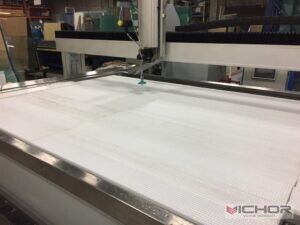
Rubber Waterjet Cutting: Precision, Efficiency, and Industrial Applications
In the world of industrial manufacturing, precision cutting techniques are essential for handling a variety of materials, and rubber waterjet cutting has emerged as a standout method for its versatility and accuracy. This process utilizes high-pressure water jets, often mixed with abrasives, to cut through rubber materials with exceptional detail and minimal waste. Unlike traditional methods that can cause heat damage or deformation, rubber waterjet cutting offers a cold-cutting alternative that preserves the integrity of the material. As industries seek more efficient and eco-friendly solutions, understanding the nuances of rubber waterjet cutting becomes crucial. This article delves into the core aspects of rubber waterjet cutting, from its fundamental principles to its practical benefits, ensuring a comprehensive grasp of why it’s a preferred choice in sectors like automotive, aerospace, and consumer goods. By exploring its technology, advantages, applications, material compatibility, and cost factors, readers will gain insights into how rubber waterjet cutting can optimize their operations. Additionally, a FAQ section addresses common queries to round out this detailed overview.
What is Rubber Waterjet Cutting?
Rubber waterjet cutting is a non-thermal cutting process that employs a high-velocity stream of water, typically pressurized up to 60,000 psi or more, to slice through rubber materials. In many cases, an abrasive substance like garnet is added to the water jet to enhance cutting efficiency, especially for thicker or denser rubber types. This method is known for its ability to produce clean, precise edges without generating heat, which prevents melting, warping, or other thermal distortions common in laser or plasma cutting. The process is highly controllable, allowing for intricate designs and complex shapes to be cut with accuracy down to fractions of a millimeter. Rubber waterjet cutting is particularly valued for its flexibility; it can handle various rubber forms, including sheets, gaskets, seals, and molded parts, making it a go-to solution in industries where precision and material preservation are paramount. By eliminating the need for secondary finishing steps, rubber waterjet cutting streamlines production workflows, reducing time and costs while maintaining high quality. As a result, it has become an integral part of modern manufacturing, offering a sustainable alternative that minimizes material waste and environmental impact.
How Rubber Waterjet Cutting Works
The operation of rubber waterjet cutting begins with a high-pressure pump that pressurizes water to extreme levels, often between 30,000 and 90,000 psi. This pressurized water is then forced through a small nozzle, creating a focused jet that travels at speeds exceeding twice the speed of sound. For cutting rubber, which can range from soft elastomers to hard compounds, an abrasive material is frequently introduced into the stream to increase cutting power. The abrasive, such as garnet or aluminum oxide, mixes with the water in a mixing tube, forming a slurry that erodes the rubber material upon impact. The entire process is controlled by computer numerical control (CNC) systems, which guide the jet along predefined paths based on digital designs, ensuring repeatability and precision. One key advantage of rubber waterjet cutting is its adaptability to different thicknesses; it can cleanly cut through rubber sheets as thin as 1 mm or as thick as 200 mm without compromising edge quality. The absence of heat in rubber waterjet cutting means there is no heat-affected zone (HAZ), which is critical for materials that could degrade under high temperatures. This cold-cutting nature also reduces the risk of toxic fume emissions, enhancing workplace safety. Overall, the mechanics of rubber waterjet cutting combine advanced hydraulics and automation to deliver a reliable, efficient method for handling diverse rubber applications.
Advantages of Rubber Waterjet Cutting
Rubber waterjet cutting offers numerous benefits that make it a superior choice in many industrial contexts. First and foremost, its cold-cutting capability ensures that rubber materials retain their original properties, as there is no thermal stress or deformation. This is especially important for sensitive applications like medical devices or automotive seals, where material integrity is critical. Another significant advantage is the precision of rubber waterjet cutting, which allows for intricate cuts and tight tolerances, reducing the need for post-processing and minimizing material waste. This efficiency translates to cost savings, as scrap rates are lower compared to mechanical cutting methods. Additionally, rubber waterjet cutting is highly versatile; it can process a wide range of rubber types, including natural rubber, silicone, neoprene, and EPDM, without requiring tool changes. The process is also environmentally friendly, as it uses water and natural abrasives, producing minimal hazardous byproducts. From a safety perspective, rubber waterjet cutting reduces the risk of accidents associated with sharp tools or high temperatures, contributing to a safer work environment. Moreover, the automation involved in rubber waterjet cutting enables high-speed production and consistency, making it scalable for both small batches and large-volume orders. These advantages collectively enhance productivity and quality, solidifying rubber waterjet cutting as a key technology in advanced manufacturing.

Applications of Rubber Waterjet Cutting
The applications of rubber waterjet cutting span multiple industries, highlighting its adaptability and effectiveness. In the automotive sector, it is used to produce precise gaskets, seals, and vibration dampers from various rubber compounds, ensuring optimal performance and longevity in vehicles. The aerospace industry relies on rubber waterjet cutting for manufacturing components like insulation seals and gaskets, where accuracy and material integrity are vital for safety and compliance. In consumer goods, this method is employed to create rubber parts for electronics, footwear, and sporting equipment, allowing for custom designs and rapid prototyping. The construction field benefits from rubber waterjet cutting in producing sealing elements for windows, doors, and plumbing systems, where tight fits and durability are essential. Additionally, the medical industry utilizes rubber waterjet cutting to fabricate surgical gloves, tubing, and other rubber-based devices, prioritizing sterility and precision. Beyond these, rubber waterjet cutting finds use in marine applications for creating seals and liners that withstand harsh environments. The ability to handle complex geometries and diverse rubber materials makes rubber waterjet cutting a versatile solution across these sectors, driving innovation and efficiency in product development.
Material Compatibility and Considerations
When it comes to rubber waterjet cutting, material compatibility is a crucial factor that influences the cutting parameters and outcomes. This process is suitable for a broad spectrum of rubber materials, including soft varieties like natural rubber and silicone, as well as harder types such as nitrile and polyurethane. The key consideration is the rubber’s hardness and thickness, which determine the need for abrasives and the pressure settings. For instance, softer rubbers might require lower pressure and minimal abrasive to prevent over-cutting, whereas harder rubbers benefit from higher pressure and abrasive incorporation for efficient slicing. Another aspect is the rubber’s elasticity and density; materials with high rebound may need slower cutting speeds to achieve clean edges. In rubber waterjet cutting, it’s also important to account for the material’s resistance to water exposure, as some rubbers could swell or degrade if not properly handled post-cutting. Pre-cutting assessments, such as material testing and design adjustments, help optimize the process for specific rubber types. Moreover, environmental factors like humidity can affect the cutting efficiency, so controlled conditions are often recommended. By understanding these material considerations, operators can fine-tune rubber waterjet cutting setups to maximize precision and minimize waste, ensuring high-quality results across different applications.
Cost and Efficiency Factors
The cost and efficiency of rubber waterjet cutting are influenced by several variables, including equipment investment, operational expenses, and material utilization. Initially, the setup for rubber waterjet cutting involves purchasing high-pressure pumps, CNC systems, and abrasive delivery mechanisms, which can be capital-intensive but offer long-term savings through reduced tool wear and lower energy consumption compared to thermal methods. Operational costs include water and abrasive consumption, maintenance, and labor; however, rubber waterjet cutting often proves cost-effective due to its high speed and minimal waste generation. For example, the ability to nest multiple parts closely in a single rubber sheet reduces material scrap, lowering overall expenses. Efficiency is further enhanced by the process’s automation, which allows for continuous operation and quick changeovers between jobs. In terms of throughput, rubber waterjet cutting can handle high volumes with consistent quality, making it suitable for just-in-time manufacturing. Additionally, the durability of waterjet equipment means fewer replacements and downtime, contributing to a favorable return on investment. When evaluating rubber waterjet cutting, it’s also important to consider indirect benefits, such as improved product quality and reduced environmental compliance costs. Overall, a thorough cost-benefit analysis typically reveals that rubber waterjet cutting is a financially viable option for many businesses, especially those prioritizing precision and sustainability.
Frequently Asked Questions
Q1: What is rubber waterjet cutting and how does it differ from other cutting methods?
A1: Rubber waterjet cutting is a process that uses a high-pressure water jet, often with abrasives, to cut rubber materials without generating heat. Unlike laser or plasma cutting, which can cause thermal damage, rubber waterjet cutting preserves material integrity and allows for precise, complex shapes without deformation.
Q2: What types of rubber can be processed with waterjet cutting?
A2: Rubber waterjet cutting is compatible with a wide range of rubber types, including natural rubber, silicone, neoprene, EPDM, nitrile, and polyurethane. The method can handle various hardness levels and thicknesses, making it versatile for different industrial applications.
Q3: Is rubber waterjet cutting environmentally friendly?
A3: Yes, rubber waterjet cutting is considered environmentally friendly because it uses water and natural abrasives, producing minimal hazardous waste. The process reduces material waste through efficient cutting and avoids toxic emissions associated with thermal methods.
Q4: How does the cost of rubber waterjet cutting compare to traditional cutting techniques?
A4: While initial setup costs for rubber waterjet cutting can be higher, it often proves more cost-effective in the long run due to lower material waste, reduced need for secondary processing, and higher efficiency. Operational savings from minimized tool wear and energy use also contribute to its affordability.
Q5: What are the limitations of rubber waterjet cutting?
A5: Some limitations of rubber waterjet cutting include the potential for slower cutting speeds on very thick materials and the need for water-resistant handling to prevent material degradation. Additionally, equipment maintenance and abrasive costs can add to operational expenses, but these are often offset by the method’s overall benefits.
In conclusion, rubber waterjet cutting stands out as a highly efficient, precise, and versatile method for processing rubber materials across various industries. Its cold-cutting nature, combined with advanced automation, ensures high-quality results while minimizing environmental impact. By understanding its principles, advantages, and applications, businesses can leverage rubber waterjet cutting to enhance their manufacturing processes and achieve greater operational success.
continue reading
Related Posts
- 1155 words5.8 min read

